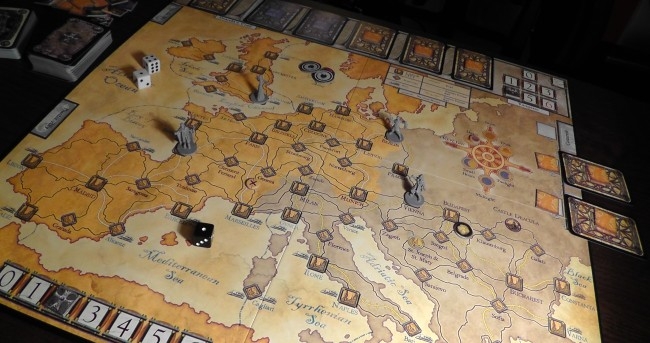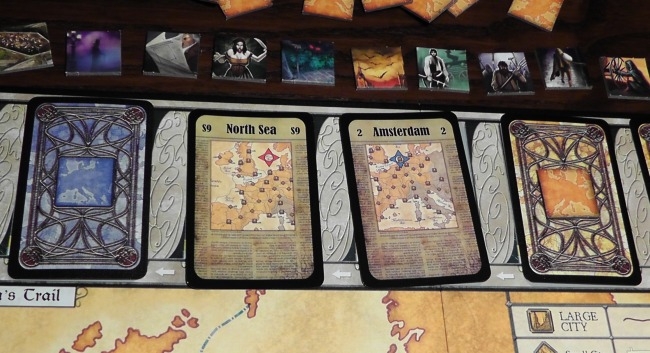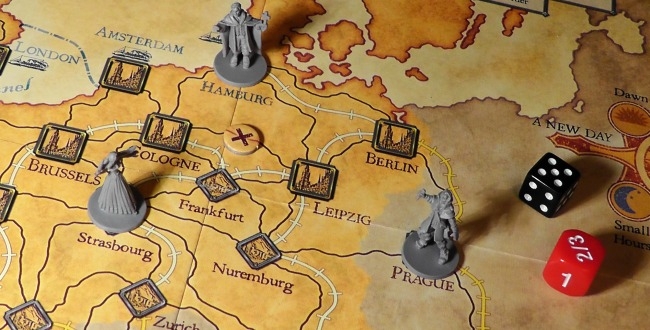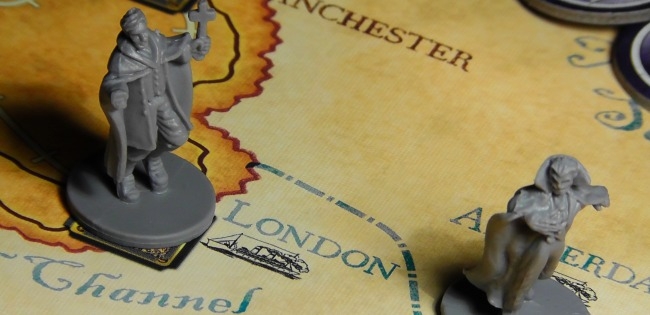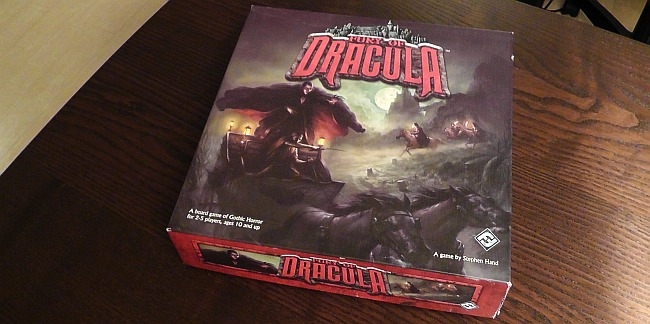Review: Fury of Dracula
Fury of DraculaQuinns' box nightmarereviewhunting the elderly
00
Quinns: Did you ever play hide and seek as a kid? Do you remember the hysterical thrill of wedging yourself under the bed, trying to control the unbelievable noise of your own lungs? Or being the hunter, creeping through a familiar environment with carbonated anticipation tingling along your veins? Because I’m inclined to call board game Fury of Dracula hide and seek for adults. This is a beautiful, beautiful game, and it deserves a place in houses the world over.
Paul: I didn’t have anywhere exciting to hide as a child or very many people to play with anyway. But we did play a game called Nine Nine In on our school field, which involved-
Quinns: FURY OF DRACULA sees four players each controlling a vampire hunter chasing Dracula across Europe. It’s a glossy update of a classic called Scotland Yard, which was a board game about catching a runaway criminal in London, but here a fifth player gets to control the immortal Count Dracula rather than some greasy burglar, so it’s already the better game.
Paul: And a bit more Gothic or romantic. There’s only so much excitement to be found in chasing someone who’s stolen a Skoda from a lockup in Peckham. Fury of Dracula gives you most of 19th Century Europe, with all its huffing trains, winding lanes and creaking, heaving ships. Dracula could be anywhere between Galway and Genoa, or even further afield, though when the chase takes you to Eastern Europe it gets even more difficult.
Quinns: Right. Fury of Dracula might well be the only game I’ve ever played with a thematic beauty, and a physical beauty, with its embossed cards and gorgeous board, and a mechanical beauty, because the actual game on offer here is about as perfect as I’ve ever seen.
At its core Fury of Dracula is a “hidden movement” game. What that means is that while the hunters all have little playing pieces that you’ll be shuffling about between Frankfurt and Cologne, or Milan and Marseilles, Dracula keeps his playing piece off the board. Instead, he’ll be tracking his movement via a deck of cards (each bearing a printed location) that he’ll be playing, face down, into six spaces along the top of the board. That’s his “trail”. Every time a hunter moves into a land or sea location, Dracula must announce whether that location is in his trail by turning the card face up. Like this:
In the above example one of the hunters might have moved into the North Sea. Dracula turns the card face up. “Oh my god!” cries the hunter. “And that next card is a land card, so he must have moved into a port attached to the North Sea! Quick, Millicent, check out Amsterdam!” Millicent catches a train to Amsterdam, and sure enough, Dracula flips that card up as well. There are only two cards to the right of Amsterdam, meaning there are only a handful of places the count might be. The hunters start chatting, heatedly discussing possibilities, and all the while the Dracula player is listening in, giggling obnoxiously but panicking on the inside. He can feel the net closing. The game is afoot.
Paul: One of my favourite things about this game is how it isn’t merely a chase, but really is a hunt. You’re pursuing deadly prey who might, at some vital moment, take the opportunity to turn and strike before fleeing (or flapping, or dissolving) away into the darkness. The hunters are a dangerous team of professionals and not to be trifled with and, sure, Dracula is outnumbered, but he’s not necessarily outclassed. If you think catching him will end the game then, well, oh dear. You’re in for a terrible surprise.
Should a hunter spot Dracula skulking past the Trevi Fountain, or corner him on a dead end in Prague’s Old Town, he’s not simply going to put his hands up and declare “It’s a fair cop, guv.” Dracula is a master of escape, a shapechanger extraordinaire and irritatingly athletic for a centuries old walking corpse. It’s generally a pretty bad idea for a single hunter to go up against a vampire and Dracula’s player might well want to take a nip at an isolated, lonely pursuiant. Finding the sanguine sonofabitch is only the start of it. You need to organise how you take him down.
Quinns: Worse, you see all those square tokens in the above image? Those are nasty little encounters that Dracula gets to place, face-down, on every location he visits. Unveiling of a scrap of Dracula’s trail is a victory for the hunters, yes, but also a potentially wince-inducing brush with a thief, an assassin, a saboteur, or perhaps something more earthly- a blinding fog, a pack of wolves, even a bolt of lightning. And as Paul says, it all gets tougher in Eastern Europe. Should Dracula retreat to his Translyvanian castle then the hunters will know about it from their spies, but they’ll have to ride even less reliable trains to get them there, while Dracula will have the aid of even more reliable minions.
Paul: That’s one of the best things about this pursuit and as Dracula getting the chance to seed the path behind you with all sorts of ambushes and inconveniences is a joy. You’ll even find yourself wanting to lure the hunters onwards, to tease them and to torture them with your traps. Won’t you, Quinns!
Quinns:…yes.
Paul: Quinns, why don’t you tell the story of the first time you were Dracula.
Quinns: …I deliberately walked into the same city as a hunter.
Paul: And why did you do that, Quinns.
Quinns: …because it was night, when Dracula is strongest, and I thought fighting one of my hunters would be awesome.
Paul: But it wasn’t awesome, was it, Quinns.
Quinns: No.
Paul: No. Quinns actually got himself killed and all of our friends had to leave my house early. Playing as Dracula is an amazing experience, because you’re at once an empowered, invisible skirmisher, yet the tiniest of mistakes will be pounced on by the four minds united against you.
As a hunter, you’re similarly torn. It’s vital you stay on Dracula’s scent in spite of all the dangers he may have seeded, but you’re also on the lookout for something else: Your prey can leave new vampires in his wake, biting helpless damsels in whatever European bedsit he decides to visit next. Should Dracula’s player draw a New Vampire encounter token, and should that recently-nibbled damsel fail to be located before her token drops off the track at the top of the board… well, she’s matured into a brand new vampire and boosted Dracula two whole days closer to his objective of surviving for six days. Meaning the hunters are at once trying to lock Dracula into some geographic dead-end while worriedly cleaning up his mess.
Quinns: This whole game is a puzzle, a thick hotpot of Hungarian goulash for the brain, and it’s made ever-spicier by the powers at Dracula’s disposal. The twin rules that hobble Dracula, that he must move every turn and can’t cross his own trail, are broken by his Hide and Double Back cards. Then there’s Feed, which restores some of Dracula’s dwindling stock of blood but the card is double-sided, so when he drops it into his trail you know he’s standing still for a bite to eat. You just don’t know where. Or do you?
Then, THEN there’s the terrifying legal outcast that is Dracula’s Wolf Form power, which means he can move twice in one turn- for example, clean through the net that the four of you have strung around him. Excellently, nothing stops Dracula from using Wolf Form with the “Hide” card, meaning the hunters will start assuming Dracula just leapt across the map, when in reality he’s right where you originally suspected. Or didn’t expect.
Heh. I’ll tell you another great thing about Fury of Dracula. As a hunter, you don’t have to work very hard to get into character. You want this bastard dead.
Paul: Similarly, the Dracula player will start drawing an evil thrill from outwitting and outmaneuvering four others, playing all the clever tricks they can, taking all the most confusing route possible and doing their very best to throw all four players off the scent all while getting the chance to listen to their pathetic theories. It is tremendously, tremendously exciting to rush about Europe either as the hunter or the hunted and this game seems all too much fun for an adult, which makes me wonder if playing it causes me to regress to a younger mental state. Ten years old, maybe.
Quinns: Sure. Or Paul circa 10,000 B.C., hiding from bears and hunting squirrels.
Paul: I like bears.
Quinns: Not as much as they like you.
Paul: As I mentioned, it’s also not necessarily over the moment Dracula is pounced on. Combat can be bloody and unforgiving, but it’s not necessarily the end of all things. Hunters can employ a variety of weapons or special items against the Transylvanian troublemaker and the vamp himself will, if he plays his cards right, often foil everything with a well-timed strike or even by dissolving into a vampiric mist. The hunters might catch Dracula just once and finish him for good, or they might win and lose difficult fights in half a dozen different locations, in Lisbon or Liverpool, each side injuring the other, before retreating to lick (or suck) their wounds. This isn’t necessarily a quick game and it can make for a long, tense and very exciting evening.
Quinns: And of course, having no idea whether each showdown is going to end the game or just leave a hunter with a bite and a broken ego lends unbelievable tension to the game. Everything’s to play for, all the time, until finally the hunters are standing over Dracula’s ashen corpse, gasping for breath.
Because I should mention neither myself or Paul have ever seen Dracula win a game of this. And isn’t that a great reason for you to buy it? Surely you, the person reading this, have got what it takes to outwit a posse of upstart mortals.
Paul: Listen. I was doing fine as Dracula and then I had to go and catch the last tube.
Quinns: Oh, don’t worry. I remember you fleeing into the night.
Paul: Hmph.
Listen! This is definitely a game to buy, a great showcase of just how tense and terrific a time you can have sat around a table with your friends. The only downside is that you really want to have five players in all five roles to get the best out of it, but there’s nothing to stop a player taking on the role more than one hunter. With each hunter having to hold their own hand of cards it’ll be both a literal and figurative handful, but it’ll still the chase of your life.
Quinns: That’s not the only downside.
Paul: Oh God. You’re not going to start talking about the box inlay again are you.****
Quinns: Right, first of all, shut up, second of all, this game comes with the most catastrophically stupid plastic inlay I’ve ever seen. It’s dumbfounding. First of all you have those three massive rectangular holding pens. For what? What did the man or sea sponge or whatever it was that designed this think that the inlay would be storing? Then you’ve got the cylindrical thing which I guess has to content itself with doing a shoddy job of holding the dice, because it’s a touch too small to hold the fragile miniatures which are instead left to rattle around inside those cavernous pens. And then, then there are the indents that hold the cards. Which aren’t big enough to hold the cards. I’ve had to wrap my cards in plastic bags so they don’t spill outwards like drunks from a club at closing time the moment I move the box. It’s-
Paul: Quinns, really, I don’t think the peopl—
Quinns: I’M NOT FINISHED. There’s also a slight indentation on one corner of the inlay that allows the game to hold the postcard-sized character sheets, but the inlay is only lowered on one side, so if you tilt the box even slightly in two of four possible directionsthose reference cards will go wandering around the box. The whole thing is, in fact, meticulously designed so that anybody who opens it after the box has been so much as nudged is going to have a terrible time.
Paul: The outside of the box looks good, though.
Quinns: Well… yes. Yes, it does.
Quinns: Ah, who am I kidding. Buy it!

